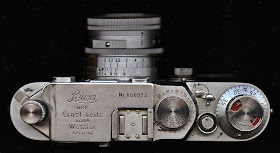 |
| My Leica IIIF |
The Short Goodbye Goes Dutch
Today I put 2013 into my head and subtracted 1975 from it. I will confess I used a pocket calculator. The result, 38 years, is the time I have spent (almost as paid magazine work has been spotty in these last three years) as a magazine photographer in Vancouver, British Columbia.
 |
| The sure thing with the Polaroid back & Fuji Instant Film |
That measure of success has mostly to do
that when possible I liked to leave nothing on chance. Before the advent of
digital cameras, I used a Polaroid back to check my shots and their exposure, or
to see if my camera was working properly. Before the Polaroid, the expensive
Polaroid back that mated with my medium format camera, I relied on two of
everything, a plan B and, yes, a plan C. On any job I always had a backup.
 |
| Bronwen Marsden - Leica IIIF - Kodak T-Max rated at 800 |
The 90s fight between the film camera and the digital camera had a milder but no less important precursor situation. In the mid 50s the king of cameras was the beautifully crafted rangefinder camera. Some of the better units had a something called parallax compensation. Since these cameras had a separate viewing system for the photographer that was not looking through the camera’s lens as was the case for the then new-fangled single lens reflexes, you mostly got what you saw through the viewfinder. But parallax compensation did not work well when you got close. If not careful the tops of heads were cut off, or the feet of people standing, etc. Finally by the mid 60s the lovely rangefinders, the Contaxes and the Leicas were in decline and professionals depended on the reflex cameras where the image through the lens was exactly what you got. Of course it all depended on your exposure and other factors like careful focusing. Not putting film in a camera could make the tenderfoot professional into a has-been tenderfoot professional. I did that trick and many more that I will not list here.
Recently I had an assignment to photograph
a baroque group from Quebec.
My Fuji X-E1 digital camera did not fail. What failed was the connecting safe
sync that mates my camera to my studio flash system. Luckily I had brought my
medium format camera and I was able to complete my job with no problem.
For fun I photographed one of my favourite
subjects, Bronwen Marsden as a woman from a Raymond Chandler novel. I photographed
her in her bedroom and I used to Nikon FM-2 cameras with film, one Mamiya RB-67
medium format camera with film and also the Fuji X-E1.
But there was an extra camera in this pleasant photographic endeavour. I used an early 50s vintage Leica IIIF with a not very bright rangefinder and with no parallax compensation. I took almost one roll of film. Many of the pictures are not quite in focus as the focusing and its limit of one meter is untrustworthy. But I experienced some disappointment at cut off wrists, head, feet and very important a theatrical gun and a cocktail cup.
But there was an extra camera in this pleasant photographic endeavour. I used an early 50s vintage Leica IIIF with a not very bright rangefinder and with no parallax compensation. I took almost one roll of film. Many of the pictures are not quite in focus as the focusing and its limit of one meter is untrustworthy. But I experienced some disappointment at cut off wrists, head, feet and very important a theatrical gun and a cocktail cup.
Since I can remember working as a
photographer I have never worked in conditions of being exposed to uncertain
and unpredictable results. Even the pinhole body cap of my Mamiya with which I
can take very nice pinhole photographs I check with the camera’s Polaroid back
(Fuji still
makes some sort of instant film for my back).
On the other hand there was a thrill in
discovering gems among those “severed limbs”.


